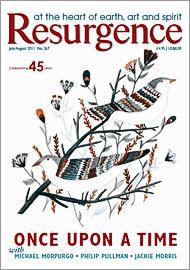In his essay in this book, Robert Macfarlane quotes Max Weber and defines disenchantment (Entzauberung) as “the knowledge or belief that…there are no mysterious incalculable forces that come into play, but rather that one can, in principle, master all things by calculation”.
Weber’s concept has been widely used to characterise the experience of the modern world, which, among other things, is perceived without a sense of wonder. The contributors to Towards Re-Enchantment: Place and Its Meanings work against ‘disenchantment’, principally by focusing their attention upon a particular place in England, Scotland or Wales.
Ken Worpole, for example, in his essay on Mersea Island and the Essex coast, strikes a note of realism that is shared by all the contributors when he criticises the “Romantic view of Nature which took little or no notice concerning matters of livelihood or human flourishing, concentrating on the effects of landscape on the viewer’s sensibility rather than on the felt experience of those who lived and worked in it”.
One consequence of this concern for history and human society is that the book does not neglect urbanised, industrialised or post-industrial places and landscapes; it includes notable contributions by Iain Sinclair, explorer of “the myth and matter of London”, Jane Rendell, and Worpole. Nor are any of the poems – by Robin Robertson, Elisabeth Bletsoe, Lavinia Greenlaw and Alice Oswald – ‘Romantic’ in a weak sense of the word.
A strong poetic spirit characterises some of the essays. Jay Griffiths, situating herself inside the ancient yew associated with the grave of Dafydd ap Gwilym among the ruins of the Cistercian abbey at Ystrad Fflur in Ceredigion, reflects on how Dafydd “sung himself into the land”. Kathleen Jamie, in her essay on Rona, remarks on “the sensation I always have on Atlantic islands, in summertime, when the clouds pass quickly and light glints on the sea – a sense that the world is bringing itself into being moment by moment”. Iain Sinclair generously gives over part of his essay on Springfield Park to the recorded words of the Chinese poet Yang Lian, who says: “The key word, not only for Lea Valley, but all other matters, is awareness”.
Awareness of language distinguishes all the writers in their use of words, while several explore the relationship between language and place. Thus Richard Mabey, writing about Norfolk, says: “East Anglian language is one of the markers of the region’s sense of what it is…[T]here are more dialect words for water than the Inuit have for snow.”
The most sustained exploration of the relationship between language and place is Macfarlane’s account of the language used on the Island of Lewis to designate the moorland. “A slow capillary creep of knowledge has occurred here, up out of landscape and into language. The result is a lexis so supplely suited to the place being described that it fits it like a skin.”
Language loss is a crucial factor in the disenchantment of place. As Macfarlane says of modern English, “A basic language-literacy of Nature is falling from us. And what is being lost along with this literacy is something perhaps even more valuable: a kind of language-magic, the power that certain words possess to enchant our imaginative relations with Nature and landscape.”
A lesson to be learnt from this is that there is vital work for poets to do, and indeed for all image-makers, such as the painters and photographers represented in this book. The focus of the writers as they bring to bear an awareness that re-enchants is upon the existence of place in time: both the living moment, and the lives that have made a place; this temporal duality is shown memorably by Bletsoe in her long poem Votives to St. Wite. Drawing on modernist techniques, this is a verbal palimpsest, in
which St Wite, the saint of Whitchurch Canonicorum, in Dorset, is presented as the spirit of the place.
The result is a wonderful poetic embodiment, in which St Wite is ‘wedded’ to the place, an incarnate spirit present in the total ecology, natural and geological, and in language – words of her own time, and words of now. The poem, as, variously, the book as a whole, is alive with ‘language-magic’.






